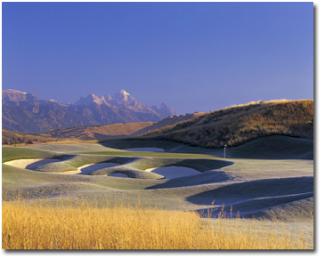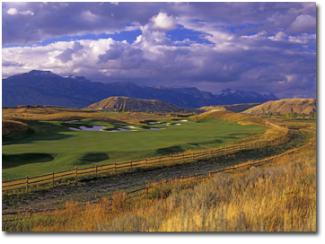Featured Golf News
Golf in Jackson - Where the Tetons are Quite Grand
There's an expression that's become common in Jackson, Wyo., over the last couple of decades: The billionaires are pushing the millionaires out of town. The incredibly rustic terrain, the soaring drama of the Tetons, the accessibility to Yellowstone National Park, the world-class skiing, climbing and fishing in a hard-to-get-to location have combined to make Jackson one of the most sought-after, and consequently priciest, locales in the American West.
The golf scene is also getting richer with each passing season, albeit slowly, though it's only the most hopelessly addicted or sadly sedentary that travel to Jackson Hole simply to golf. That would be like jetting into Vegas just to gorge on buffets. It's part of the appeal, but shouldn't be the main focus of the journey. This outdoorsman's adventure-land is full of natural wonders amidst millions of federally protected acres. Abundant wildlife, staggering peaks, rushing rivers, towering conifers and sparkling lakes are all part of the landscape.

Teton Pines
Teton Pines is an Arnold Palmer-Ed Seay design now more than 20 years old. This is an eminently walk-able resort layout on the valley floor, midway between Jackson itself and the legendary ski resort about a dozen miles from town. It's not markedly different than a hundred other similar resort properties, though the warp-speed greens, several with comical undulations, ridges and false fronts, are particularly troubling.
The length of the Teton Range flanks the west side of the 7,400-yard, par-72 track. To the east is the Sleeping Indian, a massive rock formation that looks a bit like Snoopy prone on the top of his doghouse. To the south lies the lone triangulation of Wolf Mountain, and to the north, the single defining feature of Jackson Hole - the jaggedly imposing Grand Teton itself, snowcapped even in late summer, northwest Wyoming's essential landmark.
Nowhere is the Grand framed more imperially than on the brutal seventh hole, a par-5 measuring some 600 yards from the penultimate tee box. Players aim towards the distant peak on all three shots, as the overwhelming majority has no hope of reaching the pond-fronted green in two. Wind, water, linoleum greens and insidious rough are just half the battle at Teton Pines. Most visitors will have a hard time keeping their heads down long enough to execute solid shots. It's nigh impossible to avert one's gaze from the Grand for very long as the view is far too mesmerizing.
Jackson Hole Golf and Tennis Club
The Jackson Hole Golf and Tennis Club is a straightforward design dating from the early '60s, with a Robert Trent Jones Jr. redesign some 10 years later. The course stretches almost 7,200 yards from the tips, but the slope rating is a tame 123, indicating that most of the trouble is on the periphery of this serpentine course routing. The first few holes offer spot-on views of the Grand Tetons looming to the north. Then the course turns away from the mountains, and several holes in succession are defined by corridors of cottonwoods that serve to narrow the landing areas and frame the target.
The best hole on the property is the 11th, a par-5 dogleg-left with the arid remnants of the Gros Ventre River flanking the left side of the landing area. With rushing springtime waters a pull hook from the tee would simply splash down. But the drought conditions of August instead showcased a more noteworthy result, a ball that ricocheted interminably amidst the boulders and fallen hardwood on the parched riverbed. It's still three from the tee, but at least the visuals from any mis-hit shot hold more interest. The course is scheduled for a future facelift, which should only enhance a solid routing in a spectacular location, but one that's frayed around the edges, with marginal conditions and tired bunkering.
3 Creek Ranch
3 Creek Ranch is the first high-end private golf club in greater Jackson, and this Rees Jones' design is located just a short distance south of the town center. It's a 700-plus-acre property, and besides the lovely mountain panorama, the three creeks on property not only provide truth in advertising but fabulous fly-fishing opportunities as well as a wonderful golf experience. 3 Creek was constructed on old farmland, and is mostly open terrain with lots of Rees Jones' signature containment mounding. There are few trees, plenty of water in play, and some great Teton views on the inward nine.
Snake River Sporting Club
By contrast, Snake River Sporting Club plays firmer and faster with a totally secluded feel. The course slithers between tree-covered mountains and the Snake River, though close-up views of the famed waterway are conspicuously lacking. Nevertheless, the course provides a rousing morning of golf and serves as just a slight "comeback" for an architect that's slipped just a bit from the conscience of the golf cognoscenti.
Tom Weiskopf is the designer-of-record, and the former British Open and U.S. Senior Open champ was the "it" designer of a decade or more past. But he has been superceded in recent years by the likes of Crenshaw-Coore, Jim Engh and Tom Doak. However, the Snake River Sporting Club shows Weiskopf is back with a vengeance as he provides an elegant, linear routing, peppered with hardwoods on the outward nine and surrounded by wetlands as a player heads for home. The greens are topsy-turvy, and woe to the poor golfer who finds himself 60 feet and four separate levels from the flag on the drive-able par-4 second!
The golf course is contained within a total of 550 acres, of which nearly 90 percent has been preserved as open space. But that's just a pinprick on the landscape, considering the 3.4 million-acre Bridger-Teton National Forest (an area of land larger than the state of Connecticut) borders this pristine property, which also offers private access to 6.5 miles of Snake River frontage.

When next in Jackson, be sure to run the river, spy a buffalo or moose, hike in Teton National Park, enjoy a tram ride to the apex of the ski area and grab a saddle at the Million Dollar Cowboy Bar. But if you can swing the access, do not miss the chance to visit the absolutely stellar Snake River Sporting Club.
Joel Zuckerman, called "One of the Southeast's most respected and sought-after golf writers" by Golfer's Guide Magazine, is an award-winning travel writer based in Savannah, Ga., and Park City, Utah. He has written five books, and his course reviews, player profiles, essays and features have appeared in more that 100 publications internationally, including Sports Illustrated, Golf, Continental Magazine, Travel & Leisure Golf, Sky Magazine, Golf Connoisseur, Golfweek, Estates West, Millionaire and Golf International. For more of Joel, visit www.vagabondgolfer.com.
Story Options
 |
Print this Story |
